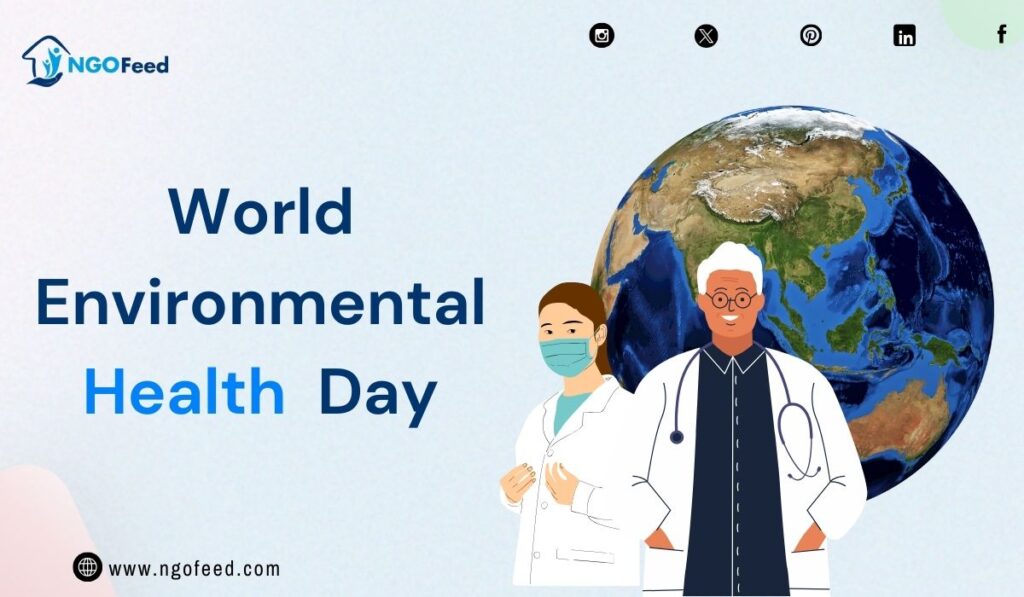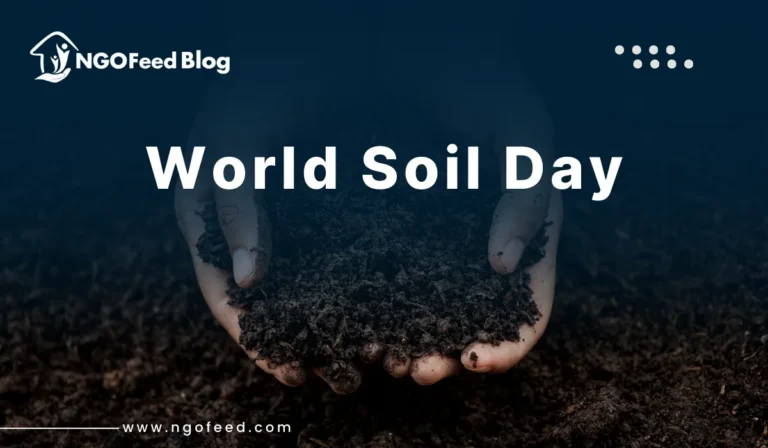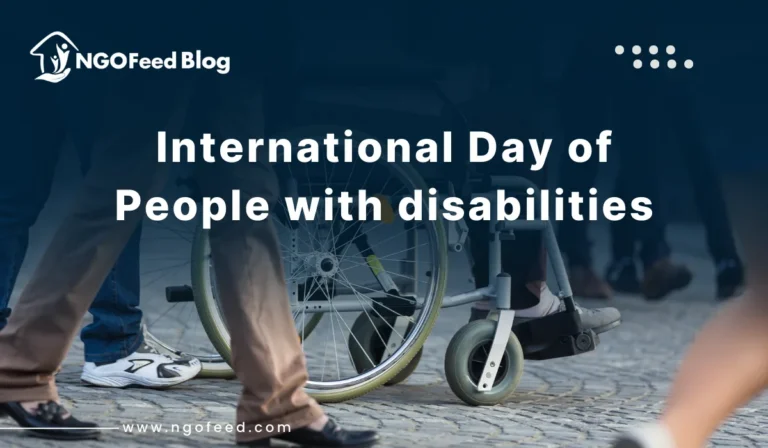World Environmental Health Day (WEHD) is recognized every year, on 26 September. WEHD is an international day of awareness to emphasize the health connection between people and our environment. WEHD is organized by the International Federation of Environmental Health (IFEH). The purpose of the day is to raise awareness, get communities involved and to ensure that people, communities, governments, institutions and the working public recognize environmental health is not separate from health; environmental health is a foundation for sustainable living.
The theme for World Environmental Health Day (WEHD) in 2025 is “Healthy Planet, Healthy People: Addressing Climate, Pollution and Health Inequities.” WEHD highlights the significance of climate change, pollution, loss of biodiversity, environmental degradation and human health and well-being which should remind us all that these issues are urgent and action is needed.
Table of Contents
About World Environmental Health Day 2025
The goal of World Environmental Health Day is to increase public awareness of the important relationship between environmental health and human health. This day aims to inspire individuals, groups, and governments to take major initiatives toward improving the environment that directly impacts human health. The day covers various environmental health issues critical for sustainable living, from waste management to safe housing and clean air and water.
The History and Purpose of World Environmental Health Day
World Environmental Health Day was first declared in 2011 by the International Federation of Environmental Health. Since then, it has been celebrated globally every 26 September with changing themes reflecting pressing environmental health issues.
The day has three main objectives:
- Raise Awareness – Spread knowledge about environmental health challenges.
- Promote Action – Encourage governments, NGOs, and individuals to implement eco-friendly and health-oriented policies.
- Foster Collaboration – Build partnerships among professionals, policymakers and citizens for a healthier world.
In 2025, the day has grown into a global campaign, with schools, universities, NGOs, local communities and policymakers engaging in awareness drives, clean-up programs, research presentations and advocacy initiatives.
Why Environmental Health Matters?
Environmental health is the branch of public health that focuses on the interaction between people and their environment. It covers air, water, soil, waste, chemicals, climate, and biodiversity.
Key Reasons Why It Matters:
- Climate Change Impacts: Rising temperatures increase the spread of vector-borne diseases like malaria and dengue.
- Air Pollution: Linked to millions of premature deaths annually, especially from respiratory and cardiovascular diseases.
- Water and Sanitation: Contaminated water causes cholera, diarrhea and other preventable illnesses.
- Food Security: Soil degradation and pollution threaten global food systems.
- Waste Management: Improper disposal of plastics, chemicals and e-waste harms both ecosystems and human health.
A healthy environment ensures disease prevention, improved quality of life and sustainable development.
World Environmental Health Day 2025 Theme: Healthy Planet, Healthy People
The theme for 2025 emphasizes a holistic approach: human health cannot be separated from planetary health. If the planet suffers, people will too.
Focus Areas of the 2025 Theme:
- Climate Resilience – Building systems that can withstand climate-induced disasters like floods, droughts and heat waves.
- Pollution Reduction – Addressing air, water, and soil pollution to reduce health risks.
- Equity in Environmental Health – Ensuring vulnerable populations have equal access to clean resources and are not disproportionately affected by environmental hazards.
- Sustainable Practices – Encouraging renewable energy, sustainable agriculture and circular economy models.
This theme resonates deeply with the UN Sustainable Development Goals (SDGs), particularly Goal 3 (Good Health and Well-being), Goal 6 (Clean Water and Sanitation), Goal 11 (Sustainable Cities) and Goal 13 (Climate Action).
Why Celebrate World Environmental Health Day 2025?
It is important to celebrate World Environmental Health Day for many reasons.
- Raise Awareness: It helps in bringing attention to the ways that environmental elements like pollution, dangerous materials, and climate change affect human health.
- Encourage Action: To reduce the dangers to public health from the environment, governments, organizations, and individuals are encouraged to take proactive steps on this day.
- Promote Education: It helps communities make educated decisions by spreading information about environmental health challenges and solutions.
- Celebrate Success: It offers a chance to acknowledge and honour the progress made in raising environmental health standards and guidelines.
How to Celebrate World Environmental Health Day 2025
There are various ways to celebrate World Environmental Health Day, and everyone can make a unique contribution:
- Participate in Community Events: participate in or plan community events like awareness campaigns, educational seminars, or clean-up drives.
- Educate Others and Yourself: Learn about environmental health issues and impart your knowledge to loved ones.
- Promote Change: Encourage local, national, and international policies and programs that are meant to enhance environmental health.
- Adopt Sustainable Practices: Include energy-saving techniques, waste reduction strategies, and the use of sustainable items in your everyday life.
Environmental Health Challenges in 2025
- Climate Change and Extreme Weather: Unprecedented floods, wildfires, droughts and hurricanes in recent years highlight the urgent need for climate adaptation. Millions of people are being displaced and public health systems are under severe strain.
- Air Pollution: According to the World Health Organization, 99% of the global population breathes air exceeding safe quality limits. Cities in Asia and Africa face severe smog crises, leading to asthma, lung cancer and early deaths.
- Water Pollution and Scarcity: By 2025, nearly half of the world’s population faces water scarcity. Industrial effluents, untreated sewage, and microplastics in water sources endanger both aquatic life and human health.
- Plastic and Chemical Waste: Microplastics are now found in human bloodstreams and even in placentas. Hazardous waste disposal remains a growing problem for urban areas worldwide.
- Vector-Borne Diseases: Changing temperatures and rainfall patterns allow vectors like mosquitoes and ticks to thrive in new regions, expanding the reach of diseases such as malaria, Zika and Lyme disease.
Global Initiatives to Protect Environmental Health
- International Federation of Environmental Health (IFEH): IFEH continues to lead by creating networks of environmental health professionals, promoting research and encouraging best practices in waste management, food safety, and sustainable living.
- United Nations and WHO Programs: The UN and WHO have integrated environmental health into their 2030 Agenda for Sustainable Development, linking it with poverty reduction, gender equality and universal health coverage.
- Paris Climate Agreement and COP Summits: International climate negotiations now highlight health as a critical co-benefit of climate action. Countries are urged to submit stronger climate commitments while ensuring health adaptation strategies.
- Local and Grassroots Movements: Community-driven initiatives such as afforestation programs, zero-waste campaigns and clean-water projects are proving that small-scale efforts can bring large-scale impact.
Role of Individuals in Promoting Environmental Health
While governments and institutions lead policies, individuals also have a significant role to play.
Simple Steps Individuals Can Take:
- Reduce Plastic Use: Opt for reusable items.
- Save Water and Energy: Prevent wastage at home and workplaces.
- Promote Sustainable Transport: Walking, cycling and using public transportation to reduce emissions.
- Proper Waste Disposal: Segregating biodegradable and non-biodegradable waste.
- Support Eco-Friendly Policies: Voting and advocating for leaders who prioritize environmental health.
The Link Between Environmental Health and Social Justice
Environmental degradation does not affect everyone equally. Vulnerable populations such as the poor, elderly, women and children face disproportionate risks.
For example:
- Communities near industrial areas often face higher cancer and respiratory illness rates.
- Rural populations dependent on agriculture are at risk from climate-induced droughts and floods.
- Marginalized groups may lack access to clean water, sanitation, and healthcare services.
Recognizing environmental justice is crucial for building equitable and sustainable societies.
Case Studies: Positive Examples of Environmental Health Action
- Rwanda’s Plastic Ban: Rwanda’s strict ban on single-use plastics has reduced plastic pollution significantly and improved public health.
- India’s Swachh Bharat Mission: This nationwide sanitation campaign improved access to toilets and reduced open defecation, leading to better public health outcomes.
- Europe’s Green Energy Transition: Many European nations are rapidly shifting toward renewable energy, cutting emissions and improving air quality.
These success stories prove that policy, combined with community engagement, can transform environmental health landscapes.
The Next Steps: A Call to Action
World Environmental Health Day 2025 reminds us that protecting health means protecting the planet. Governments need to enact stricter regulations, industries need to adopt innovative approaches in a sustainable way, and individuals must act responsibly.
Priorities for the Future:
- Stronger policies- Enforcing air and water quality standards with significantly higher compliance.
- Climate adaptation – Building stronger infrastructure and stronger health systems.
- Public engagement – Building awareness and engaging communities.
- Research and innovation – Develop green technologies for waste, clean energy, and food systems.
- Cooperation – We need countries to work in partnership to address environmental health threats that know no borders.
Conclusion
On 26 September 2025, World Environmental Health Day makes it clear that a healthy environment is the basis of healthy lives. The air we breathe, the water we drink, the soil that produces the food we grow and the climate that we depend upon, all these can directly affect our health and health outcomes.
“Healthy Planet, Healthy People” is the theme for this year, emphasizing the fact that the capturing of the planet is not only an environmental responsibility but a health responsibility. When climate change, pollution and inequity are all at a distressing increase, the need for some collective action on a local, national and global level is becoming more important than ever.
When we raise awareness, increase our commitment towards acting and celebrate World Environmental Health Day 2025, we will go one step closer to a future where the health of humans and the health of the world we live in, coexist and prosper cohesively.










